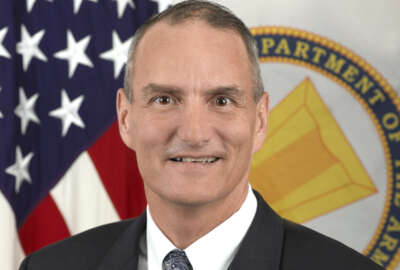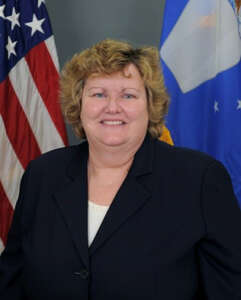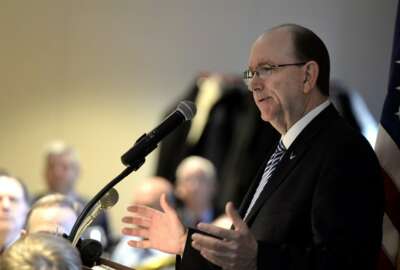
The big data challenge getting smaller for Army, Air Force as CDOs mature
Greg Garcia, the deputy CIO and chief data officer for the Army, and Eileen Vidrine, the Air Force’s CDO, are finding ways to increase the value of data that is...
In naming a chief data officer, the Army and the Air Force took different approaches with an eye toward the same goal.
The Army dual-hatted its deputy chief information officer with CDO responsibilities. The Air Force named a specific individual to oversee and manage its data.
But no matter the path the military services, or really any agency, takes, it’s all about extracting more value out of the data they have and taking advantage of the information in different ways.

Greg Garcia, the deputy CIO and chief data officer for the Army, said being the CDO is a new job for him and a great opportunity escalate the position for a senior person to be in charge of the data.
“The one benefit [of being both deputy CIO and CDO] is it really is from inspiration to execution in a very simple manner for me,” Garcia said during a panel at the recent AFCEA NOVA small business IT day, which was part of Ask the CIO. “We have specifically in the Army dedicated some cloud money. What we found out is you don’t necessarily have to move applications to get the value out of the data. You can move the datasets into a big data platform or data lake and extract some data. What I have been able to do as CDO is throw this new element into my new role as deputy CIO and say, ‘Maybe some of this cloud money doesn’t go to applications, but maybe I extract value out of moving data first versus always thinking about moving applications first?’ For me, that was great synergy. For other organizations, it depends on maturity and it depends on your mission goals.”
The Air Force, meanwhile, has been out in front in terms of not only naming someone to lead its data governance and management efforts, but also in extracting that value. The service named its first CDO in 2017 and Eileen Vidrine, the current CDO, came on board in 2018.
“We have a concept called the digital Air Force, which is about optimizing people, process and technology to optimize how we perform. It’s a partnership in the Air Force where I work on a daily basis with the deputy CIO Bill Marion and the deputy chief management officer Richard Lombardi so we are really looking at not just what the data is, but how we are optimizing the business processes to move forward,” she said. “Because we are all aligned under the same leader, we really have an opportunity to gain velocity, which is really exciting. It’s part of our daily conversation.”

She said as part of this digital Air Force effort, her office created a small lab at Andrews Air Force Base where data scientists, data architects and the functional or mission experts to explore use cases that have the potential to address enterprise challenges.
“In our first year, we just wrapped up our 15th use case and several of them are now being scaled across the enterprise. We take a problem set, we use data science to solve it and then we use that as the seed to grow the next use case moving forward,” Virdrine said. “When we began, most of our use cases we asked people, ‘How can we help you to work smarter?’ Now people knock on our door and we have turn people away because we don’t have enough capability.”
The Army, which released its updated data plan in November with an execute order for the offices, bases and commands, is taking advantage of its information from procurement and cyber perspectives.
Garcia said that by putting the service’s financial data in a big data platform under the category management initiative, the Army better understands more about $12 billion in spending. In 2019, the Army saved more than $1 billion through this effort.
“In our IT area, we have something called Gable Nimbus, which is an additional big data platform where all of our cyber data is fused into. We have unprecedented visibility of all data that was formally independent streaming data from our cyber sensors into one place where data analysts can go into,” he said. “We’ve also fielded the Army Leadership Dashboard where we’ve taken over 135 different data sets and put them in a big data platform so now we can see readiness like we’ve never seen readiness before. It not only correlates the data but it actually gives us projections to say if you move this person to this job or fix vehicle with this part that is available here, you can get your readiness from C2 to C1. It’s a remarkable capability.”
Related Stories

Army saved more than $1B through category management, and it’s just a start
Acquisition Policy
Read more
Senior leaders recognize value of data
Related Stories

Army saved more than $1B through category management, and it’s just a start
Garcia said the Army also is adding new artificial intelligence and machine learning capabilities to these big data platforms, which will help them be smarter and more predictive in their planning.
“It’s really about data that is correlated to have insights that you no longer as a system or application owner you cannot answer the question anymore with what you have in your application. It really needs all sources to come to bear on that,” Garcia said. “That has driven the desire of senior leaders to recognize that. This is coming from top down. This isn’t really a bunch of smart people saying ‘We need to worry about data.’ It’s the senior leaders saying, ‘We need to worry about data. Data is the new strategic asset that we must get in front of.’”
Vidrine said the Air Force is working on several different initiatives to get a better hold on its data. She said the service held an industry day late in 2019 to talk about bringing in data services, including tools and taking advantage of commercial data sets.
“The other piece the Air Force has been working on is we’ve worked a lot with the defense innovation community. Just last spring, we did a multi-domain operations challenge with AFWerx. There were 300 proposals,” Vidrine said. “The CDO community in DoD may be really small, but we are really connected and support each other moving forward. When we have successes we share them. In my lab, we developed a methodology for how to run a use case. We put together a workshop on how to run a use case and it was attended by all the services.”
Copyright © 2024 Federal News Network. All rights reserved. This website is not intended for users located within the European Economic Area.
Jason Miller is executive editor of Federal News Network and directs news coverage on the people, policy and programs of the federal government.
Follow @jmillerWFED






